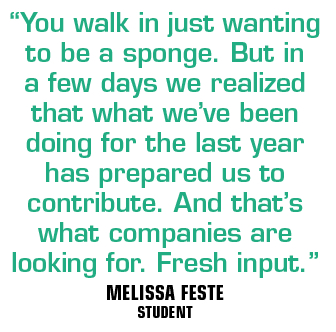Ellen Schmidt-Devlin’s path to a 27-year career at Nike began on the track at the University of Oregon.
A distance runner, she was cooling down at the end of her first collegiate race when she was approached by a well-regarded, retired track coach who was tinkering with new designs for running shoes.
“Hi, my name is Bill Bowerman,” he said. “Would you get the girls on the team to test Nike shoes?”
It was 1976, only four years after the passage of Title IX and well before its impact percolated up into college athletics.
“Nice to meet you, Mr. Bowerman,” Schmidt-Devlin told Nike’s co-founder. “But we’re not girls. We’re women.
“He thought that was pretty funny, and we became fast friends.”
On a June morning this year, Schmidt-Devlin opened the door to a brick building near the Portland waterfront,
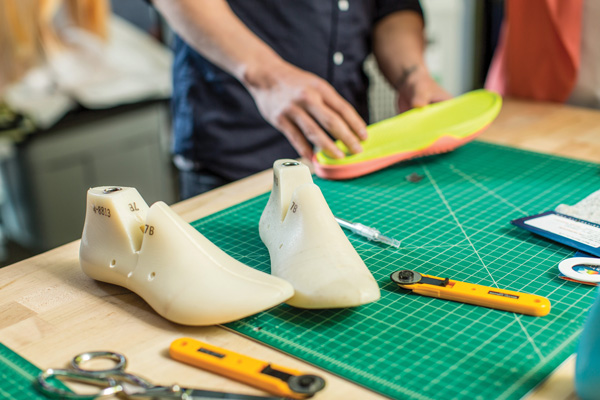 |
A student in the sports product management program works on a sneaker design.
Photo by: University of Oregon |
welcoming visitors into a room stocked with much of the equipment needed to make sneakers, basketball jerseys, training jackets and other sports apparel: racks of fabric swatches, tables on which to cut patterns, an array of sewing machines designed to stitch fabric or leather, a small 3-D printer, mannequins and a pegboard to hold tools.
On the wall next to the tools was a declaration: “Sports product innovation starts here.”
The White Stag Innovation Lab at the University of Oregon is the brainchild of Schmidt-Devlin, who last year launched a first-of-its-kind master’s program at her alma mater, an 18-month program that offers a Master of Science degree in sports product management, to date the only degree of its kind in the country, and one of few like it offered in the world.
Already known for its Warsaw Sports Marketing Center, which for 20 years has offered a sports-focused MBA and an undergraduate sports business concentration, Oregon doubled down on the industry last year, rolling out a program designed to identify, educate and feed talent to athletic shoe, apparel and equipment manufacturers, which are to Portland and the surrounding region what fashion and finance are to New York.
By the school’s count, some 900 companies operating in Oregon identify themselves as playing in the sports product industry. About 90 percent of them are in Portland.
Filling a gap
To the uninitiated — such as those bitten by the bug to work in sports — the differences between sports management and sports product management might seem nuanced. But they often lead down different paths.
The sports marketers at Nike, Adidas and Under Armour, for example, are charged with using connections to leagues, teams and especially athletes to sell their wares and forward their brands. They decide, for example, whether to sign LeBron James and produce a collection bearing his name, and how to execute a campaign around him.
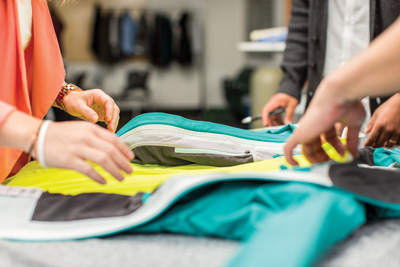 |
The program was seen as a natural fit given the University of Oregon’s proximity to hundreds of companies in the state that are involved in the sports product industry.
Photo by: University of Oregon |
The sports product team designs James’ shoe and apparel line, chooses the materials that will be used, shepherds production through factories, and builds a retail strategy to take the product to consumers.
Companies such as Nike and Adidas employ far more people in sports product than in sports marketing. And yet no U.S. university offered a program tailored to produce candidates qualified for those jobs.
That gap became apparent to Schmidt-Devlin six years ago when, after retiring from Nike, she went back to school for her Warsaw MBA. While she was in school, her alma mater invited her to teach a sports product management class.
At the end of the 10-week session, many students approached her with the question you’d expect: “How do I get my job at Nike.”
“Well, I don’t think you do,” Schmidt-Devlin told them. “I think I’m an OK teacher, but you don’t know that much more than anybody else. You have 30 more hours of experience on the product side, but you have no other product class. These are product companies. I don’t see how I get you from where you are now to where you want to be in these companies.”
That realization got Schmidt-Devlin thinking. She spoke with longtime sports marketing professor Dennis Howard about the gap and possibilities for filling it. He arranged a meeting for them with the business school dean.
Faculty and administrators at Warsaw were in the early stages of crafting a new strategic plan. One of the growth areas they identified was sports product. It was something the program had discussed for years, but never with a resolution.
“This narrative of really creating something special in sports product had been bubbling up for a while,” said Whitney Wagoner, who has taught at Warsaw for a decade and last year took over as its director. “It’s a natural fit for us. And if we had the chance to be clean slate and blue sky, this would have been core to what that thing would and should have been.”
In the meeting with the dean, Schmidt-Devlin explained that for decades, she and her Nike colleagues often joked that their jobs were something for which you couldn’t go to school. From the start, Oregon’s Warsaw program had close ties to Nike and the other sports companies in the region, but those rarely led directly to any of the many jobs on product teams.
“What can we do about that?” someone asked.
“Well, we can all sit around and say we should do this and this and this,” Schmidt-Devlin said. “Or we could go ask the industry.”
She came away with the blessing to do just that. During a three-month assessment, Schmidt-Devlin conducted more than 150 interviews and panel discussions around the region, asking what those in the industry wanted the university to provide in research, innovation and talent development. Then, she checked into what the university already offered.
“Since I didn’t come from the university, I didn’t know you were supposed to color within the lines,” Schmidt-Devlin said. “Stay in your college. Stay in your center. I didn’t know that’s what they did.”
She took a closer look at what the Warsaw program had that might apply. But she also studied the business school’s other three centers, which focus on sustainability, entrepreneurship and finance. She checked into applicable offerings in the product design, journalism and green chemistry programs. She thought about the connection between her work at Nike and the university’s study of human physiology. She pulled from each of those programs, then contemplated what specialized curriculum they would have to create from scratch.
Though the dean encouraged her to move forward after their meeting in August 2012, pairing her with retired marketing professor Roger Best to help navigate the expectations and perception of academia, there were hurdles to clear. She landed about $250,000 in funding for the innovation lab and hosted its first industry workshop late in 2013. But it took nearly two years to get approval from the master’s committee within the business school.
“There were doubters in the college,” said Bob Madrigal, a member of the business school master’s committee who serves as academic director at both Warsaw and the SPM program. “There were people on the committee who had concerns about academic rigor and making sure that it wasn’t just like a trade program. Sewing machines make it a different thing. It’s not a bad thing. But it’s a different thing. I’m OK with different. We’ve done a lot of different here. But at the same time, we are in a college of business. So we made them jump through lots of hoops and we really held their feet to the fire. And as a result, I think what they ended up with was a lot better than what they would have if not for the experience with us in the college.”
Perhaps because the business school tested it so rigorously, the product with which they emerged moved through the remaining university approvals in a matter of months. In March 2015, the state gave its preliminary blessing, enabling them to begin accepting applicants for the first entering class. Final approval came two months later.
“Every single time I’d take a trip down to Eugene, I’d turn to my husband and say, ‘This might be the last trip,’” Schmidt-Devlin said. “Like for any pioneer, I always thought it was the right thing to do. And you hope it will be the right time to do it.
“The promising thing was, there wasn’t one person we met that said this wasn’t a great idea.”
Students drawn to program
Courtney White took the typical path into a career in sports when she graduated after playing small-college tennis, starting off selling tickets for the University of Maryland while working for The Aspire Group. It didn’t take long for her to realize that wasn’t for her, so she changed directions, going to work in sales for a health food brand. She moved from there into operations, where she advanced. When her husband landed a job with the San Francisco 49ers, she took one in procurement with an organic grocer.
“I started dreading going to work,” White said. “I really had gotten off my path.”
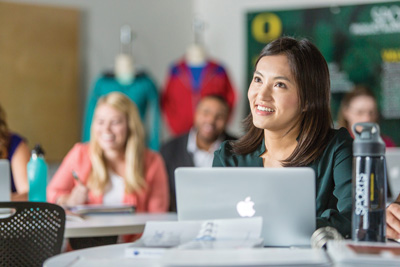 |
A total of 37 students make up the program’s inaugural class that began in the fall of 2015.
Photo by: University of Oregon |
White considered her interests and acumen and decided a job at Nike might make sense, but she realized her background wouldn’t get her more than an entry-level slot. So she started looking into an MBA. That led her to Oregon’s soon-to-launch sports product management program.
“It sounded like exactly what I needed to get a more direct path to where I wanted to go,” she said.
In today’s higher education market, the cost of that path can be substantial. When including the cost of trips to New York and Asia, the tab for the 18-month program will exceed $70,000 for most students.
This summer, White is interning at Nike along with two other Oregon sports product management students who found the program from other continents, Lucie Browning of England and Jeremy Gin of New Zealand. White is a product line manager intern in sportswear. Browning also is in sportswear, but as an engineer. Gin is in basketball.
Gin found the program while on a similar mission, though on the other side of the globe. Working in marketing for a retail sportswear company in his New Zealand home, he had greater aspirations, hoping to work for one of the large footwear brands.
Researching possible paths, he found a promo video for the startup program at Oregon. He had spent two years managing a Nike store after getting off to a bad start in college. The idea of studying down the road from the brand’s global headquarters seemed like something out of a dream.
“People from where I’m from, we don’t get opportunities like this,” Gin said. “For me to be here right now on Nike’s campus, it’s just crazy for me to think of that.”
Browning was putting a mechanical engineering degree from Cambridge to work in a consulting firm’s medical
technology practice.
“You wouldn’t believe how many different inhalers there are,” Browning said. “It was really interesting and challenging, but because those devices take 12 or 14 years, you don’t get to see it to fruition.”
She thought it might be interesting to apply her engineering skills to products in the sports world, so she Googled in search of an MBA in sports. Oregon’s new sports product management program seemed a better match for her interest in how things are made and how they work.
While those three are interning at Nike, two of their classmates, Austin Hodges and Melissa Feste, are working in basketball at Adidas.
Hodges is a small-college All-America basketball player who was coaching at his alma mater and working as a product tester for Adidas on the side when he decided he needed better connections and more training to break through.
Feste played hockey at Ohio State and then professionally in Germany and Switzerland. Bitten long ago by the bug to work in sports apparel, she applied for entry-level jobs with the usual suspects but rarely heard back.
“Now, I’ve got my dream internship at Adidas, pursuing what I always wanted to do,” Feste said. “You walk in just wanting to be a sponge. But in a few days we realized that what we’ve been doing for the last year has prepared us to contribute. And that’s what companies are looking for. Fresh input.”
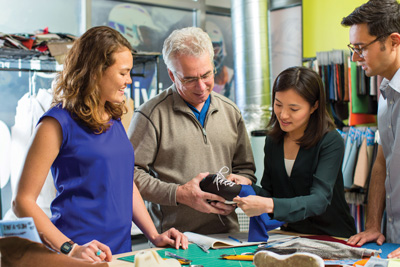 |
Student Sara Nazim (left), instructor Mike Friton and students Wan-Hsien Hsieh and Chris Sataua work in the program’s lab.
Photo by: University of Oregon |
The fact that Schmidt-Devlin was able to place three interns at Nike, two at Adidas, six at factories in Asia and 25 at 19 other companies in the sports product world — all of them paid, all in the program’s first year — speaks not only to Oregon’s connections within the industry, but even more so to the level of engagement by those companies from the start.
A page in the program’s marketing materials illustrates the breadth of its industry connections in a single glance.
Side by side in the list of companies with seats on the Oregon program’s advisory board are the logos of Nike, Adidas and Under Armour, a powerful triad you won’t see positioned together often, if ever. You’ll also find Columbia, Brooks, Bauer, Keen, New Balance, Mizuno, Intel and others — more than 40 companies that have agreed to attend four board meetings a year and provide not only advice, but also guest speakers, adjunct professors and internships.
Though Schmidt-Devlin calls upon few to teach, she has assembled a brigade of mentors, each of whom is paired with a student. Each project team has an industry “coach” to vet ideas and provide advice.
While valuable, that sort of interplay does bring the potential for conflicts. No company wants a guest speaker to reveal something that could help a competitor or to see talent poached at a workshop. Schmidt-Devlin said she works to make sure neither of those happens. But she also wants the industry to respect the program and its workshops as a place people come to be educated, rather than simply as a quick avenue to a job.
“We’re going to source talent for the industry,” Schmidt-Devlin said. “Even in our first class, it was so clear that we were finding the best talent that some of the companies took them before we started. That, I had to stop.”
At her first board meeting last year, she issued an edict.
“If we identify this talent, hands off for 18 months,” she told them. “We identified them and they are going to be right for the industry, but they’re not right now. Let us expose them to Asia. To Europe. To creating products.
Because once they go to work for you, they’re going to see this thin slice of your company. And if they’re going to lead, they need to know more. None of these larger companies have the time to teach it.”
Seizing the opportunity
Schmidt-Devlin thought back to the way she found her way into what 40 years ago was a far smaller sports product industry.
As she readied to graduate in 1980, she sent Nike’s Bowerman a letter, asking if she could use his name as a reference at his fledgling shoe company. He did her one better, offering a job that also would allow her time to train for the 1980 Olympic trials.
She didn’t make the team, but she did launch a successful and rewarding career as Nike employee No. 1,887, a
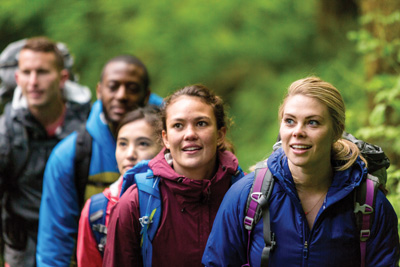 |
Melissa Feste (right), who played hockey in college and overseas professionally, is interning at Adidas.
Photo by: University of Oregon |
number so low, in relative terms, that she has to prompt Nike store cashiers to enter two zeroes in front of it to redeem her company discount.
Schmidt-Devlin’s time at the company included product development roles in Beaverton; Exeter, N.H.; Hong Kong; Japan; Thailand and South Korea, all of which would be quite familiar to those in the industry but foreign to those hoping to break into it.
For 27 years, her father, Norman, would introduce her as his daughter, Ellen, who designed Nike shoes.
“And I’d say, ‘No, Dad, I don’t do that,’” Schmidt-Devlin said, “because I spent my entire career on the business side of creation. And there are so many of those roles, from product line management to product development to operations to sourcing to manufacturing. If you’re on the business side of production, it’s like, ‘Duhhh.’ But if you’re not, you probably don’t understand it or know where you might fit.
“It’s not something that any of these companies have marketed. So it really was up to us to start marketing it for them.”
Like Schmidt-Devlin, Don Remlinger started his Nike career in Bowerman’s Eugene footwear lab. In 33 years with the company, he served varied product roles, including stints as general manager of soccer, sportswear and action sports.
“I’m not aware of anything else that serves the purpose that this program is intended to serve,” said Remlinger, who retired from Nike in October. “To me, that is its unique place. As opposed to only having access to existing talent in the industry, you now have a place for new talent that will be better prepared than in the baptism by fire, sink-or-swim world that we grew up in.”





